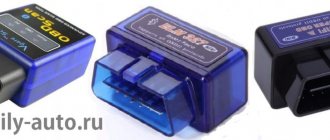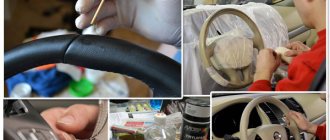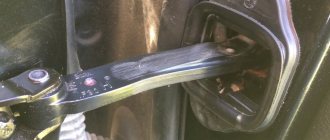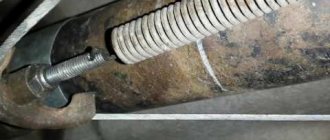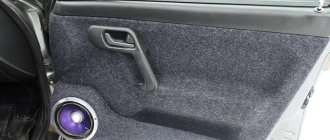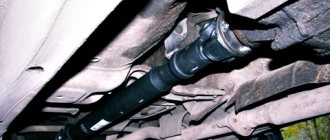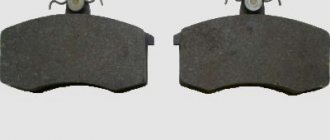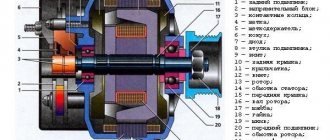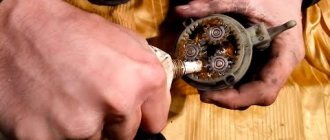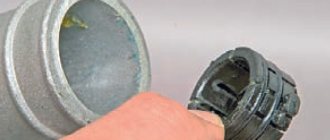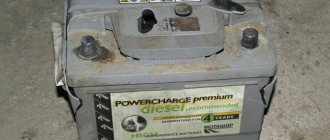Hi all! It is unlikely that anyone considers a door squeak on a car to be some kind of serious nuisance and especially a breakdown. But many are rightly interested in how to lubricate car door hinges and locks so that they work well, do not make extraneous noise, and also ensure smooth opening and closing.
The hinges, like the lock mechanism, are made of metal components. Under the influence of external and internal factors, wear, souring, etc. gradually occurs. As a result, a characteristic creaking noise appears, which is extremely unpleasant to the human ear.
To get rid of this problem, you need to use lubricant. There is only one question - which one? We’ll talk about this with you today.
How to lubricate car door hinges
It is advisable to apply lubricant to car door hinges as soon as possible after unpleasant squeaks appear when they move. Creaking occurs due to increased friction between the planes of the hinge; accordingly, increased friction leads to increased wear, which can be avoided if lubricant is applied in a timely manner. If you ignore this problem, over time the door may become “skewed”, which will lead to difficulties when closing it.
Lubricating car door hinges is not as easy as it might seem at first glance. In this case, you need to do more than just apply a lubricant to the working mechanism. It is important to properly prepare the surface before doing this. Proceed according to the following algorithm:
- Clean the surface to be lubricated beforehand from any contaminants that have formed. This can be done using, for example, a brush with coarse bristles. Since, in most cases, the dirt is “ingrained”, you can use white spirit or gasoline to dissolve it. If there are signs of corrosion, use a rust converter;
- Once the surface is clean and dry, use a lubricant. We recommend not just “filling” the hinges, but lubricating the rubbing surfaces specifically;
- After lubricating, open and close the door 20-25 times, using a rag to wipe off excess lubricant that leaks out during operation.
If the creaking persists after the hinges are lubricated, this may be due to sagging of the doors, poor-quality lubrication, poor surface cleaning, or because not all hinges are lubricated.
Please note: It is better to lubricate car door hinges in the autumn, when the heat has already ended, but the cold has not yet set in.
Dashboard
This is the most problematic area of most used cars. To understand where exactly the “play” is, you need to try pressing the plastic panels one by one while driving and listen to see if the sound has disappeared (therefore, it is better if there is an assistant in the car). You can also try to insert an unnecessary plastic card into the cracks that cause the most suspicion. If the grinding noise has disappeared, then the “cricket” has been found. All that's left is to get rid of him.
Healthy! To determine exactly at which joint the unpleasant sound occurs, it is enough to inspect the surfaces. As a rule, abrasions appear in such places.
There are two options for how to do this - simpler and more complicated:
- We completely dismantle the dashboard and put Modelin (one sheet of sound insulation will cost 760 rubles), Bitoplast (a sheet will cost 250 rubles) or so-called mushrooms (plates with small “outgrowths” that make the joints even tighter) into the joints. Particular attention should be paid to the panel's hinged elements (glove box lid, fuse box, clock, etc.).
We recommend: Why and how often to refill your air conditioner. How risky is it to do such a procedure yourself?
Healthy! Some people glue the joints with special tape or regular adhesive tape from the pharmacy.
- Pour silicone grease into the cracks (a can of WD-40 with a spout will cost about 250 rubles) and wipe off the excess with a napkin.
Silicone grease is the fastest and cheaper option. But you shouldn’t expect it to work for a long time, so the procedure will have to be repeated periodically. Fortunately, this composition is not conductive, so you don’t have to worry about “shorting” the dashboard.
Healthy! If the dashboard of a car consists of many parts (such as in the Chevrolet Lacetti), which are attached with self-tapping screws, then one disassembly is enough for extraneous sounds to begin to appear in the car. If this element is a monolith (as in Renault Logan), then even a used car will not have problems with “crickets” in this area.
A little about lubrication
Each car enthusiast has his own attitude towards his car. For some, a car is just a means of transportation, but for others it is an iron friend that needs to be taken care of regularly.
Most often, car maintenance involves regularly maintaining the shine of the car’s plastic and paintwork, as well as keeping the interior clean. But this is an insufficient level of vehicle maintenance, since there are still a lot of elements in it that can become a source of big problems in the future if they are not properly cared for.
Such elements include locks, hinges and car door seals. Caring for these machine elements involves regularly checking the lubricant level. If you find that the lubricant in the presented mechanisms is running low, then it urgently needs to be updated.
And here many car enthusiasts immediately have a question about which lubricant is more suitable for this or that mechanism, since one lubricant is needed to lubricate locks and hinges, and a completely different one is needed for car door seals.
A lubricant is a substance that has a certain base with the addition of various additives and other additional substances in order to give it more qualities.
As a rule, the lubricant contains the following substances:
- additives;
- thickeners;
- lubricating oils.
There are several types of lubricant for various automotive mechanisms. So, lubricants for automotive mechanisms are divided into the following types:
- liquid lubricant, so-called oil;
- semi-solid or plastic;
- hard.
The lubricant is also divided according to the method of application: - motor; - transmission; - universal.
If they're rusty
Without regular maintenance, door devices, as well as thresholds and arches, quickly become covered with rust. How to eliminate car doors squeaking when opening? If corrosion has been embedded in the mechanisms for a long time and tightly, then a single application of lubricant will not be enough. You should not apply several layers of the product - it is better to first remove the rust and then start coating the mechanisms. The applied product will eliminate the unpleasant sound and remove rust residues, but will not be able to penetrate deep into the hinge and corrode the corrosion from the inside.
Lubrication procedure
To begin with, I’ll briefly tell you how to properly and better process door hinges and locks so that they don’t creak and work well.
Quite often, cars are left in the garage for the winter, or are simply actively used, which leads to the gradual appearance of squeaking. The cause of the squeak is increased friction between the hinge elements. And the stronger the friction, the faster the wear. I think it’s pointless to talk about the consequences of wear and tear. But I note that under certain conditions, even a complete replacement of door hinges and quite serious repair and restoration work may be required. But if you lubricate the structure in time, the consequences will be avoided.
We recommend: Causes of car heater malfunction and its repair
Many people think that there is nothing complicated about lubrication. Apply the product and you're done.
Here the preliminary and necessarily correct preparation of the element plays a big role. Otherwise, the purchased product will be of no use. The same is the case with the treatment of door seals, which we recently talked about.
The lubrication algorithm involves performing the following procedures:
- Thoroughly clean the surface from accumulated dirt;
- Brushes, rough brushes and other similar tools are well suited for cleaning;
- If the dirt is ingrained, take some kind of solvent such as gasoline or White Spirit;
- If there are traces of corrosion, a rust converter is needed;
- Then the loops must be dried with a rag or even a hairdryer if there are hard-to-reach areas;
- Then the rubbing surfaces themselves are lubricated directly;
- Finally, you need to open and close the doors about 20-30 times;
- At the same time, remove excess lubricant.
If the creaking persists, then there may be several reasons, ranging from an incorrect procedure and poor lubrication, to sagging doors and the fact that the substance has not reached all elements.
It is not recommended to lubricate in cold weather. It is better to treat the stops and hinges in the fall, when it is not cold, but the hot period has already ended.
Common lubricants for car door hinges
Let's consider several lubricant complexes that are often chosen for car door hinges:
- Wurth HHS 2000.
A high-quality German lubricant that boasts good penetrating ability, rapid thickening, adhesiveness, and resistance to water. It can be used to lubricate car hinges and locks. The lubricant is also released in a convenient way of application. It comes in an aerosol can, the sprayed composition from which quickly transforms into a thick layer of lubricant. Among the disadvantages of such a lubricant when used for car door hinges is stickiness. When driving off-road, there is a high risk that dirt, sand, and dust will stick to it, which is why the lubricant will begin to lose its effectiveness. Also, the disadvantages include the rather high cost.
- CRC-MULTILUBE. A common lubricant for use on car door hinges. This substance penetrates well deep into the hinges, lubricating the entire mechanism. The lubricant does not lose properties at different temperatures. Among the interesting points, it should be noted the indication of lubrication, which is present in this substance. After application, the lubricant is blue in color so that the driver can see exactly where it is applied. After a few days of use, the lubricant becomes colorless.
- Liqui Moly Wartungs-Spray Weiss.
An interesting feature of this lubricant, unlike its competitors, is the presence of microceramic particles in its composition. It is designed specifically for moving mechanisms - hinges, rods, locks. The applied lubricant has an anti-corrosion effect and reduces the load on the rubbing elements. This lubricant is based on mineral oil, which is why it loses its properties at temperatures below -30 degrees Celsius. If the car is not expected to be operated at such low temperatures, the lubricant is perfect for the hinges.
- Permatex 80075 . Another lubricant that is well suited for car door hinges. This lubricant has the consistency of foam at the time of application, which allows it to penetrate as deeply as possible into the moving mechanism. Lubrication can protect the rubbing surface from excessive wear and increase their service life.
- Klever Ballistol Silicone Spray. A lubricating spray that can be used not only for car door hinges, but also for lubricating rubbing parts made of rubber, rubber, plastic and other materials.
This is only a small part of the lubricant complexes that can be used to lubricate car door hinges. In specialized automotive stores you can find a wide range of such lubricants.
What to do if there is no result
It is not uncommon for a car door to continue to squeak after treatment. Moreover, the sound is heard not when opening/closing, but when the car is moving. The reason may lie in sagging mechanisms. A crooked, hard-to-lock door is evidence of wear in the hinges.
Car owners solve this problem by replacing the pins, but the method does not always help: wear has affected not only them, but also the hinges. Even a couple of mm is enough for the metal to start “moving” inside. The solution is to score the ends of the loops with a grinder and then weld them. The gap becomes smaller - the pin fits tighter, and the door play disappears. The parts are first lubricated with a thick compound, often graphite lubricant.
Seats and trunk
Most often, “crickets” start in latches or headrests. In the second case, creaky elements should be replaced. If this is not possible, you can wrap electrical tape around the joints between the headrest. If the problem lies in the seat latches, then you should lubricate them and tighten the mounting bolts.
It is also a good idea to check the pins that go into the holes in the floor of the machine. They should be treated with silicone-based lubricant (the favorite product of many car owners is WD-40).
Additionally, it is worth checking that the “cricket” has not started in the luggage compartment. Since it contains large parts that are under high pressure, it is worth tightening the hinges and lubricating them with lubricant. If the curtain creaks, then just remove it. If problems arise with the seals, we carry out the same measures as with the doors.
Healthy! Instead of conventional lubricant, experts advise using compounds with Teflon (for example, Liqui Moly).
Also, “crickets” may appear:
- In the hatch. For the winter, it is best to treat the “window” with silicone and stick double-sided tape to the edges of the hatch itself.
- In seat belts. The latches may come into contact with plastic elements of the interior. In addition, the belts are often twisted at the fastening points.
- In the spoiler. If such an element is present in the car, the driver will hear a loud “itching” sound.
Of course, the simplest solution to the problem is to make the music louder and not pay attention to unpleasant sounds. However, this will not get rid of the problem, which will only get worse. Therefore, it is better to always keep the car clean and make sure that “crickets” do not appear.
What are they?
- Carbon (graphite). It consists of mineral oil with additives of the same substance and a thickener (calcium soap). The oil base imparts water-repellent properties. The resulting mass is dark brown or black. Suitable for use at temperatures from -20 to +70° C. Experts recommend using it when the lock has already begun to jam slightly and there are problems with turning the key. Significantly extends the life of the mechanism and protects against corrosion. Mainly used to preserve a car for a long time. One of the main advantages is the affordable price. Distributed in the form of aerosols.
- Lithium. Molybdenum disulfide and lithium are used as a base. Salt has proven itself well in care products for engines, bearings, transmissions and CV joints. Lithium minimizes friction between parts and displaces moisture. The substance prevents the start of oxidation processes and the formation of rust on metal surfaces, and is also resistant to aggressive chemicals. Among the shortcomings, it should be noted the loss of a number of useful qualities when large amounts of dust enter. On the shelves, lithium grease is presented as an aerosol (cans).
- Mineral (consistent). A time-tested product that shows impressive results. They reveal themselves well in winter, since at this time the parts are most exposed to moisture in the form of condensation. The substance has a high penetrating ability, allowing it to penetrate any keyhole without additional effort. Forms a protective film that is resistant to abrasion and washing off. Retains its qualities over a wide temperature range.
- Polymer (silicone). Modern popular solution. The base is silicone. The substance is compatible with metal, plastic and rubber. The composition is produced by all well-known companies. The resulting film remains on the surface for 2 seasons, with careful use. For active driving, treatment is recommended 2 times a season. Works in a wide temperature range. Can be used even at -50°C. High adhesive properties reduce the time of film formation after application of the substance. The layer can withstand light pressure washing. Distributed in compact cans, sprays and tubes. The paste-like consistency is rubbed in with your hands, carefully working every curve. Manipulations are carried out in protective equipment.
How to choose?
Regardless of the manufacturer, the lubricant must meet a number of requirements:
- high viscosity;
- anti-corrosion resistance;
- lubricating qualities at a high level;
- moisture resistance;
- resistance to aggressive chemicals;
- film resistant to physical impact;
- maintaining characteristics at low and high temperatures.
Only in this case the processed elements will remain safe. To maintain the required level of protection, the film must be renewed periodically.
About WD-40
A popular product, the use of which is actively promoted by many motorists. According to them, the spray can be used to lubricate locks. The action of the product can be compared to kerosene. After cleaning the part from the old lubricant, it evaporates.
The main tasks performed by WD-40:
- displacement and removal of moisture;
- rust removal.
The spray does not protect the part from wear and friction. Regular use as a lubricant will result in the need to replace the lock. Lubricating qualities produce a short-term effect.
WD-40 is indispensable in an emergency situation (it is impossible to open a frozen locking device, or parts are stuck). But after exposure, it is necessary to use a lubricant with stable properties in the near future. Otherwise, the operation of the mechanism will deteriorate.
